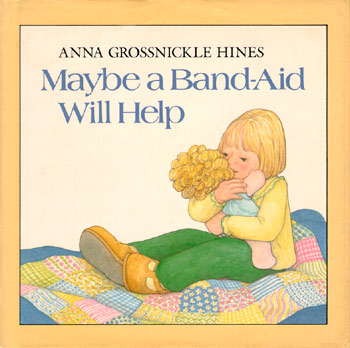Sarah had a cloth doll named Abigail. I'd made the doll and given it to her for her second Christmas, and Abigail was a great favorite. When Sarah was seven, I think, Abigail lost one of her legs. I told Sarah to put her on the washing machine with the rest of the mending and I'd fix her. Well, a couple weeks went by and Sarah came to me with Abigail in her arms and said, "She's lonely there. She won't mind if I play with her this way." As a mom, I felt incredibly guilty, but as a writer, I was inspired. What a great idea for a story! I eventually wrote it and sent it out.
My story came back from Susan Hirschman with a letter saying she loved the first sentence but just didn't believe that the mom would have taken so long to fix the doll...even though in the story I had cut the time down to just two or three days rather than weeks. "Well," I said to myself, "She's never been a mother. What does she know?" I sent it to Jim Giblin. Again it came back. Jim's comment was that it just didn't seem that important to the little girl that the doll get fixed. "Well," I said. "What does he know? He's never been a little girl with a broken doll."
It was at that point that I went to Jane's workshop. She pointed out that everything in a story must work on all levels. In my story everything should connect back to Sarah wanting that doll fixed. I had Sarah waiting, but while she waited she went off with her friends and played other games.
I reconsidered Susan and Jim's comments and realized they weren't saying they didn't believe that in real life a mother wouldn't have time to fix a doll immediately, or that it wouldn't be very important to a little girl to have it fixed. They were saying that I hadn't made them feel the mother's busy-ness, or the child's need to have her doll back.
I rewrote my story, and this time I showed the mother doing things that kept her from fixing the doll. And while Sarah waited, she never for a moment forgot Abigail. She played school and made pictures for Abigail saying, "I hope your leg gets better soon." She took a nap with Miss Mousie, unlike Abigail, who was too big and crowded her in bed. Her friends wanted to play house, but Sarah "didn't want to play anything without Abigail."
I sent the revised story back to Greenwillow. Susan said, "It's much better, but we still don't think it's irresistible enough for today's market." I sent it to Jim. He said, "It's much better, but it still needs something and I can't put my finger on it." I sent it to Ann Durrel at Dutton and she called me. She had me tighten it up from 32 pages to a 24 page book, but she loved it, wanted to publish it and wanted more stories about Sarah and Abigail.
It's a process of expanding and then cutting away. Filling in. Selecting the parts that are just right to say what I want to say.
